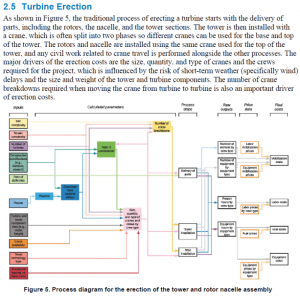by NREL, via Energy Post
 The costs of wind turbines is dropping. But that means all the other capital costs – site preparation, foundations, infrastructure, tower construction – will become a bigger part of the total. In the U.S. they currently account for around 30% of the capital expenditures needed to install a land-based wind plant. To keep those costs under control the National Renewable Energy Laboratory (NREL) has created a comprehensive open-source modelling tool, called LandBOSSE, that allows users – researchers, analysts, developers, government agencies – to input their numbers (or use industry data and trends) and estimate costs. Want to try a different mix of inputs, designs, locations and strategies? What’s the trade-off between different labour rates, foundation designs, and turbine installation methods? You can change the numbers. Each module breaks down all the costs you can put a name to. The main four modules are: foundations, site preparation, erection, electrical collection system. Other modules include: development, management, grid connection, substation construction, weather delay. Optimisation means more efficiency means better decisions.
The costs of wind turbines is dropping. But that means all the other capital costs – site preparation, foundations, infrastructure, tower construction – will become a bigger part of the total. In the U.S. they currently account for around 30% of the capital expenditures needed to install a land-based wind plant. To keep those costs under control the National Renewable Energy Laboratory (NREL) has created a comprehensive open-source modelling tool, called LandBOSSE, that allows users – researchers, analysts, developers, government agencies – to input their numbers (or use industry data and trends) and estimate costs. Want to try a different mix of inputs, designs, locations and strategies? What’s the trade-off between different labour rates, foundation designs, and turbine installation methods? You can change the numbers. Each module breaks down all the costs you can put a name to. The main four modules are: foundations, site preparation, erection, electrical collection system. Other modules include: development, management, grid connection, substation construction, weather delay. Optimisation means more efficiency means better decisions.
The contiguous United States has the technical resource potential to generate up to 32,700 terawatt-hours of electricity per year—more than eight times the amount of electricity consumed in the United States in 2018.
However, significant cost and performance improvements in wind power technology are needed for the wind industry to reach this potential.